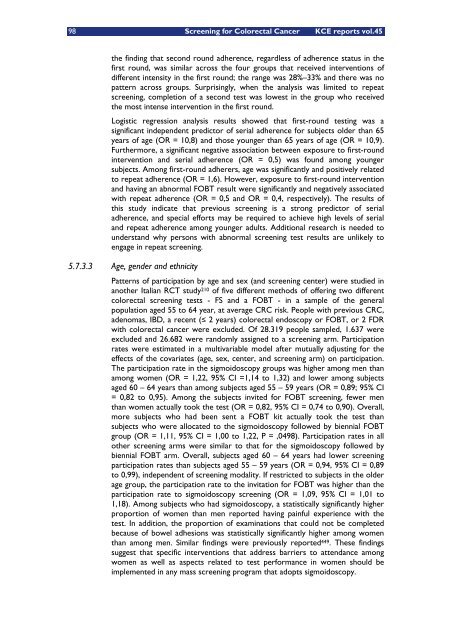Report in English with a Dutch summary (KCE reports 45A)
Report in English with a Dutch summary (KCE reports 45A)
Report in English with a Dutch summary (KCE reports 45A)
You also want an ePaper? Increase the reach of your titles
YUMPU automatically turns print PDFs into web optimized ePapers that Google loves.
98 Screen<strong>in</strong>g for Colorectal Cancer <strong>KCE</strong> <strong>reports</strong> vol.45<br />
the f<strong>in</strong>d<strong>in</strong>g that second round adherence, regardless of adherence status <strong>in</strong> the<br />
first round, was similar across the four groups that received <strong>in</strong>terventions of<br />
different <strong>in</strong>tensity <strong>in</strong> the first round; the range was 28% 33% and there was no<br />
pattern across groups. Surpris<strong>in</strong>gly, when the analysis was limited to repeat<br />
screen<strong>in</strong>g, completion of a second test was lowest <strong>in</strong> the group who received<br />
the most <strong>in</strong>tense <strong>in</strong>tervention <strong>in</strong> the first round.<br />
Logistic regression analysis results showed that first-round test<strong>in</strong>g was a<br />
significant <strong>in</strong>dependent predictor of serial adherence for subjects older than 65<br />
years of age (OR = 10,8) and those younger than 65 years of age (OR = 10,9).<br />
Furthermore, a significant negative association between exposure to first-round<br />
<strong>in</strong>tervention and serial adherence (OR = 0,5) was found among younger<br />
subjects. Among first-round adherers, age was significantly and positively related<br />
to repeat adherence (OR = 1,6). However, exposure to first-round <strong>in</strong>tervention<br />
and hav<strong>in</strong>g an abnormal FOBT result were significantly and negatively associated<br />
<strong>with</strong> repeat adherence (OR = 0,5 and OR = 0,4, respectively). The results of<br />
this study <strong>in</strong>dicate that previous screen<strong>in</strong>g is a strong predictor of serial<br />
adherence, and special efforts may be required to achieve high levels of serial<br />
and repeat adherence among younger adults. Additional research is needed to<br />
understand why persons <strong>with</strong> abnormal screen<strong>in</strong>g test results are unlikely to<br />
engage <strong>in</strong> repeat screen<strong>in</strong>g.<br />
5.7.3.3 Age, gender and ethnicity<br />
Patterns of participation by age and sex (and screen<strong>in</strong>g center) were studied <strong>in</strong><br />
another Italian RCT study 210 of five different methods of offer<strong>in</strong>g two different<br />
colorectal screen<strong>in</strong>g tests - FS and a FOBT - <strong>in</strong> a sample of the general<br />
population aged 55 to 64 year, at average CRC risk. People <strong>with</strong> previous CRC,<br />
adenomas, IBD, a recent ( 2 years) colorectal endoscopy or FOBT, or 2 FDR<br />
<strong>with</strong> colorectal cancer were excluded. Of 28.319 people sampled, 1.637 were<br />
excluded and 26.682 were randomly assigned to a screen<strong>in</strong>g arm. Participation<br />
rates were estimated <strong>in</strong> a multivariable model after mutually adjust<strong>in</strong>g for the<br />
effects of the covariates (age, sex, center, and screen<strong>in</strong>g arm) on participation.<br />
The participation rate <strong>in</strong> the sigmoidoscopy groups was higher among men than<br />
among women (OR = 1,22, 95% CI =1,14 to 1,32) and lower among subjects<br />
aged 60 64 years than among subjects aged 55 59 years (OR = 0,89; 95% CI<br />
= 0,82 to 0,95). Among the subjects <strong>in</strong>vited for FOBT screen<strong>in</strong>g, fewer men<br />
than women actually took the test (OR = 0,82, 95% CI = 0,74 to 0,90). Overall,<br />
more subjects who had been sent a FOBT kit actually took the test than<br />
subjects who were allocated to the sigmoidoscopy followed by biennial FOBT<br />
group (OR = 1,11, 95% CI = 1,00 to 1,22, P = ,0498). Participation rates <strong>in</strong> all<br />
other screen<strong>in</strong>g arms were similar to that for the sigmoidoscopy followed by<br />
biennial FOBT arm. Overall, subjects aged 60 64 years had lower screen<strong>in</strong>g<br />
participation rates than subjects aged 55 59 years (OR = 0,94, 95% CI = 0,89<br />
to 0,99), <strong>in</strong>dependent of screen<strong>in</strong>g modality. If restricted to subjects <strong>in</strong> the older<br />
age group, the participation rate to the <strong>in</strong>vitation for FOBT was higher than the<br />
participation rate to sigmoidoscopy screen<strong>in</strong>g (OR = 1,09, 95% CI = 1,01 to<br />
1,18). Among subjects who had sigmoidoscopy, a statistically significantly higher<br />
proportion of women than men reported hav<strong>in</strong>g pa<strong>in</strong>ful experience <strong>with</strong> the<br />
test. In addition, the proportion of exam<strong>in</strong>ations that could not be completed<br />
because of bowel adhesions was statistically significantly higher among women<br />
than among men. Similar f<strong>in</strong>d<strong>in</strong>gs were previously reported 449. These f<strong>in</strong>d<strong>in</strong>gs<br />
suggest that specific <strong>in</strong>terventions that address barriers to attendance among<br />
women as well as aspects related to test performance <strong>in</strong> women should be<br />
implemented <strong>in</strong> any mass screen<strong>in</strong>g program that adopts sigmoidoscopy.

















